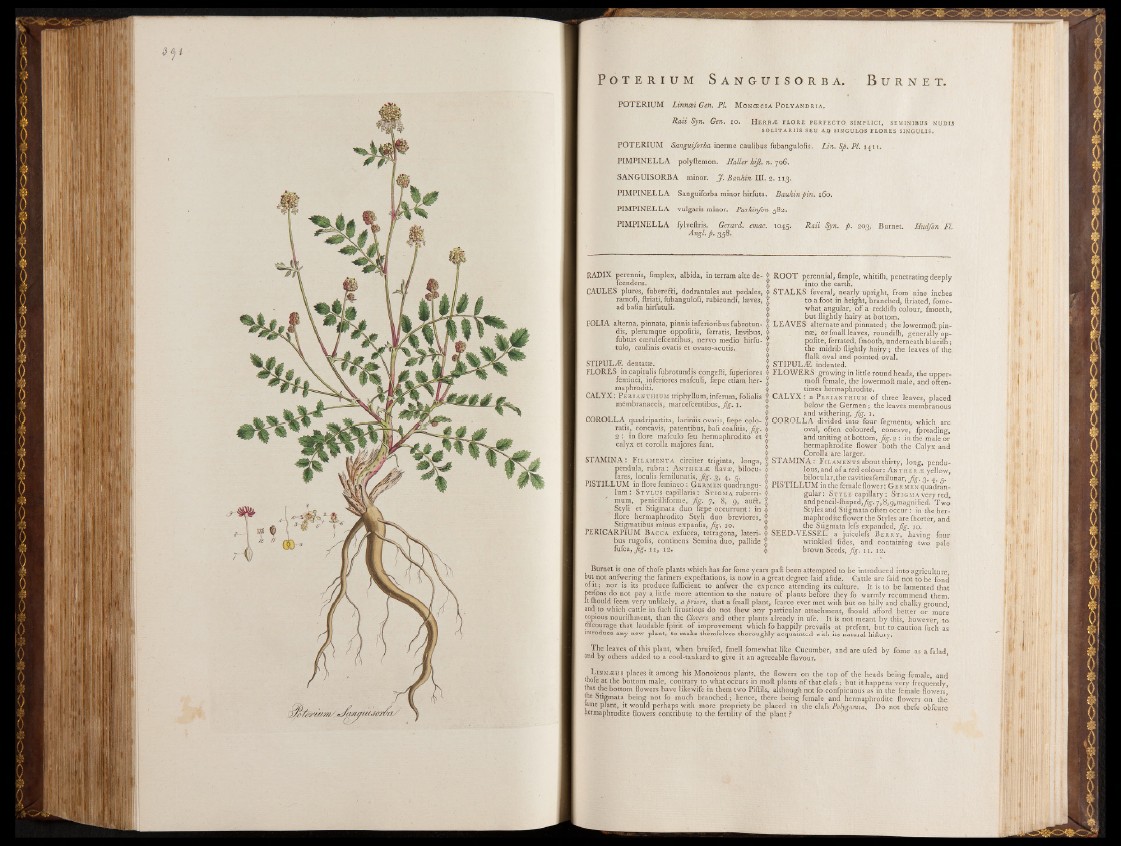
^ C > f ô C > î îK > * :K 3 -M < > â irC > îjr<
P O T E R I UM S a NGUI S O R B A . B u r n e t .
POTERIUM Linncei Gen. PL M oncecia P o l y a n d r i a .
Raii Syn. Gen. 10. H e r b a : f l o r e p e r f e c t o s im p l ic i , sem inibus n u d is
SOLITARIIS SEU AI} SINGULOS FLORES SINGULIS.
POTERIUM Sanguiforba inerme caulibus fubangulofis. Lin. Sp. Pl. 1411.
PIMPINELLA polyftemon. Haller hiß. n. 706.
SANGUISORBA minor. jf. Bauhin HL 2. 113.
PIMPINELLA Sanguiforba minor hirfuta. Bauhin pin. 160.
PIMPINELLA vulgaris minor. Parkinfon 582.
PIMPINELLA fylveßris. Gerard, emac. 1045. Raii Syn. p. 20Q, Burnet. Hudfon FL
Angl. p. 358.
RADIX perennis, fimplex, albida, in terrain alte de- <
fcendens.
CAULES plures, fubere&i, dodrantales aut pedales, jj
ramofi, ftriati, fubangulofi, rubicundi, læves, ]
ad balin hirfutuli.
FOLIA alterna, pinnata, pinnis inferioribus fubrotun- ]
dis, plerumque oppofitis, ferratis, lævibus, *
fubtus ccerulefcentibus, nervo medio hirfu- 1
tulo, caulinis ovatis et ovato-acutis., î
STIPULÆ dentatæ. )
FLORES in capitulis fubrotundis congefti, fuperiores <
feminei, inferiores mafculi, fiepe etiam her- )
maphroditi. •> ^
CALYX: Perianthium triphyllum,inferum, foliolis 1
mëmbranaceis, marcefcentibus, fig . 1. \
COROLLA quadripartita, laciniis ovatis, faepe colo- ^
ratis, concavis, patentibus, baß coàlitis, fig. %
2 : in flore mafculo feu hermaphrödito et 1
calyx et corolla majores funt. J
STAMINA: Filamenta circiter triginta, longa,!:
pendula, rubra: A n t h e ræ flavæ, bilocu- |
lares, loculis femilunatis, fig. 3, 4, 5. |
PISTILLUM in flore femineo : G ermen quadrangu- 1
lum : Stylus capillaris : Stigma ruberri- I
mum, penicilliforme, fig. 7, 8, 9, au6t. |
Styli et Stigmata duo fiepe occurrunt : in |
flore hermaphrodito Styli duo breviores, f
Stigmatibus minus expanfis, fig. 10.
PERICARPIUM B acca exfucca, tetragona, lateri-
bus rugofis, continens Semina duo, pallide ;|
fufca, 11, 12.
ROOT perennial, Ample, whitilh, penetrating deeply
into the earth.
STA LK S feveral, nearly upright, from nine inches
to a foot in height, branched, ftriated, fome-
what angular, o f a reddifh colour, fmooth,
but flightly hairy at bottom.
LEAVES alternate and pinnated ; the lowermoft pinnae;
or fmall leaves, roundifh, generally op-
pofite, ferrated, fmooth, underneath blueifh;
the midrib flightly hairy ; the leaves o f the
ftalk oval and pointed oval.
STIPULÆ indented.
FLOWERS growing in little round heads, the upper-
moll female, the lowermoft male, and often-
• times hermaphrodite.
C A L YX : a P e r ia n th iu m of three leaves, placed
below the Germen ; the leaves membranous
and withering,^. 1.
COROLLA divided into four fegments, which are
oval, often coloured, concave, fpreading,
and uniting at bottom, fig. 2 : in the male or
hermaphrodite flower both the Calyx and
Corolla are larger.
STAMINA: F il am e n t s about thirty, long, pendulous,
and of a red colour: A n th e r æ yellow,
bilocular,the cavities femilunar, fig. 3 , 4, 5.
PISTILLUM in the femaleflower: G ermen quadrangular:
S t y l e capillary : S t ig m a very red,
andpencil-lhapedjjijg-.7,8,9,magnified. Two
Styles and Stigmata often occur : in the hermaphrodite
flower the Styles are fhorter, and
the Stigmata lefs expanded, fig. 10.
SEED-VESSEL a juicelefs B e r r y , having four
wrinkled fides, and containing two pale
brown Seeds, fig. 11. 12.
Burnet is one of thofe plants which has for fome years paft been attempted to be introduced into agriculture
but not anfwering the farmers expe&ations, is now in a great degree laid afide. Cattle are faid not to be fond
of it ; nor is its produce fufficient to anfwer the expence attending its culture. It is to be lamented that
perfpns do not pay a little more attention to the nature of plants before they fo warmly recommend them.
It Ihould feem very unlikely, a priori, that a fmall plant, fcarce ever met with but on hilly and chalky ground]
and to which cattle in fuch fituatiops do not fliew any particular attachment, Ihould afford, better or more
copious nourifliment, than the Clovers and other plants already in ufe. It is not meant by this, however, to
difcourage that laudable fpirit of improvement which fo happily prevails at prefent, but to caution fuch as
introduce any new plant, to make themfelves thoroughly acquainted with its natural hiftory.
The leaves o f this plant, when bruifed, fmell fomewhat like Cucumber, and are ufed by fome as a falad
and by others added to a cool-tankard to give it an agreeable flavour.
th IJ.INN^ TJSKPIaces lt ainaong his Monoicous plants, the^flowers on the to|> o f the heads being female, and
î at the bottom male, contrary to what occurs in raoft plants o f that clafi ; but it happens very frequently,
k o • b°ttom flowers have likewife in them two Piftils, although not fo confpicuous as in the female flowers]
the Stigmata being not fo much branched ; -hence, there being female and hermaphrodite flowers on the*
jame plant, it would perhaps with more propriety be placed in the clafs Polygamia, Do not thefe obfcure
hermaphrodite flowers contribute to the fertility of the plant ?